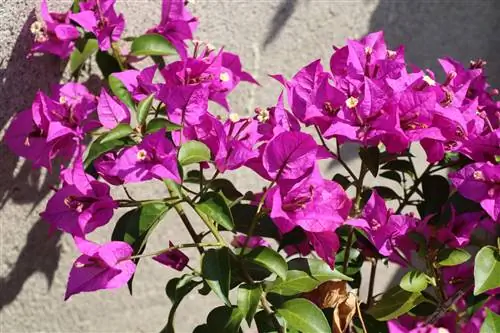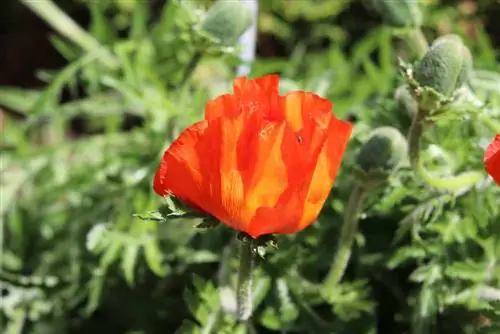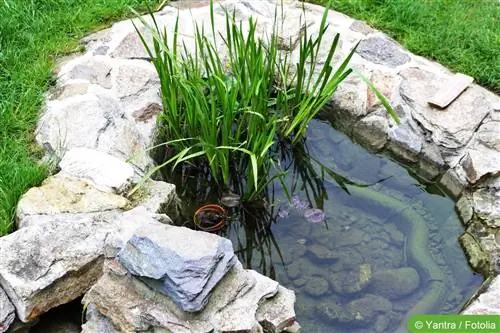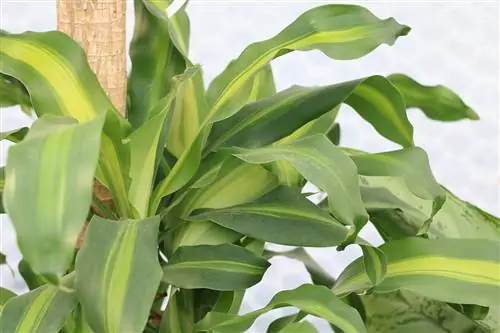- Author admin [email protected].
- Public 2023-12-17 03:39.
- Last modified 2025-01-24 12:45.
In general, the mimosa is kept as a houseplant in our latitudes, but you can also put it in the garden in summer. The mimosa, also known as touch-me-not, belongs to the legume family (Fabaceae, Leguminosae) and the subfamily of the mimosa family (Mimosoideae).
The right location for mimosas
The mimosa comes from tropical South America, where it grows in the forests. In this country, mimosa is cultivated as an ornamental plant. Especially as a houseplant.
The Mimosa appreciates a bright and very quiet location. The mimosa does not like direct sun and young plants in particular should be completely protected from direct sunlight. The plant is relatively undemanding when it comes to temperatures, but it absolutely does not like frost. Normal room temperature or outdoor summer temperatures without direct sunlight are perfect for the plants.
It is important that the plants are not exposed to drafts and that they do not experience constant vibrations, because in this case the leaves and small branches contract regularly. This is very stressful for the plant and permanently weakens it.
Soil and fertilization
The soil for the plant should be loose and compost-based. After purchasing, you should repot the plant immediately and check it regularly, because mimosas grow relatively quickly. If the roots stick out of the bottom of the pot, it's time to repot. The soil should always be slightly moist, but the plant cannot tolerate too much water. So it needs to be watered moderately but regularly. If it gets too much water on a regular basis, it will still absorb it, but will ultimately die.
In order for the plant to grow well, it needs regular fertilization. However, the plant also survives without fertilization. For fertilization, you should use commercially available green plant fertilizer, but only give it in half the recommended concentration. Young plants should not be fertilized yet.
Mimosa: origin of the name
The mimosa is an extremely interesting plant because it reacts to touch or shock. If you touch the plant, it folds its leaves. And all in a split second. It can take up to half an hour for the leaves to stand up again. This folding of the leaves can also be observed at night, as a sleeping position, so to speak. At night the plant does not react so noticeably to touch.
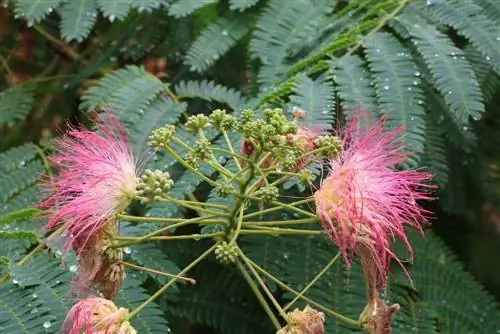
The mimosa has long, thin shoots that have protective thorns. It has only a few leaves and only grows to a height of around 50-70 cm. Mimosa flowers don't last long. Each flower only lives for one day. However, it quickly produces new buds, which also open in a very short time. This means you always have flowers on the plant during the flowering phase. It blooms in a very beautiful pink color.
Mimosa Care
The mimosa is not that easy to care for. Mimosa plants want to be relatively moist, but they cannot tolerate waterlogging. She has the ability to get drunk. It absorbs water over and over again until it eventually falls over. If that happens, it is already too late and the plant can no longer be saved.
- A bright location, without direct sunlight, is preferred.
- She feels most comfortable at room temperature; frost and drafts are not tolerated.
- It is best to place the plant so that it can stand still without having to be touched frequently (overhanging shoots).
- Each folding of the leaves costs the plant a lot of energy and should therefore be avoided.
- The mimosa grows quickly, so frequent repotting is necessary. If the roots come through at the bottom of the pot, this is a sure sign that it should be repotted.
- Repotting should be done as quickly as possible in order to expose the plant to as little stress as possible.
Cutting the plant
If the plant becomes very bulky, a cut is recommended. However, you should cut the plant as rarely as possible and avoid cutting young mimosas completely. After cutting, it is always uncertain whether the plant will sprout again as desired. This is often not the case and the mimosa looks a bit plucked after the cut. It is easier to grow a new plant from seeds - which is very easy - and then replace the old and bulky plant with the young mimosa.
The propagation of mimosa
The mimosa is very easy to grow from seeds even for laypeople:
- The perfect time for sowing is spring. It makes sense to let the seeds germinate beforehand.
- To do this, pour hot water over the seeds and then let them soak for several hours, causing them to swell slightly.
- If necessary, repeat the watering process if the seeds do not swell in the first attempt.
- Then the seeds are ready for planting. To plant the seeds, you use sowing soil or cocohum, as both are germ-free.
- The seeds must be covered with a thin layer of soil. The location for the sowing container should be light and warm.
- It is important to keep the substrate evenly moist. A spray bottle is suitable for watering because it allows you to moisten in a better dosage.
Diseases and pests of mimosa
A pest that attacks mimosa more often is the spider mite, which can be recognized by the fine web that surrounds the plant and is best seen when spraying the plant with water. For first aid, the plant is then carefully rinsed with a jet of water. It is then necessary to use a spray against the pest because rinsing does not eliminate all the animals and because two surviving pests are enough to start a new population on the mimosa.
Sensible is a systemic agent that is absorbed by the plant and is absorbed by the spider mites when the plant is sucked out. Repeated use is important in order to destroy the eggs. Especially during the wintering phase, the risk of spider mite infestation is very high due to the drier indoor air. However, mimosas should be checked regularly for spider mite infestation at any time of the year.
Overwintering mimosas
The mimosa is a plant that likes to remain dormant in the winter. However, overwintering is not very difficult as the plant only reaches a height of 30 to 50 centimeters and therefore does not have any high demands on locations. The mimosa can easily stay outside up to 10 degrees Celsius outside temperature.
- In later autumn it is brought into the house and overwintered in a room that is bright and has a room temperature of around 15 degrees Celsius. The humidity must not be too low, otherwise the plant will be attacked by spider mites.
- The care requirements of the mimosa are very low in winter. That's why it needs to be watered even less in the winter than in the summer and fertilizing is not necessary during the wintering phase.
- From around February, the plant is first placed in a room that has normal room temperature. You should slowly get the plant used to the sun again, otherwise its leaves will burn quickly.
- Therefore, after winter rest, you should place the plant in the shade or partial shade, where it is definitely protected from the midday sun.


